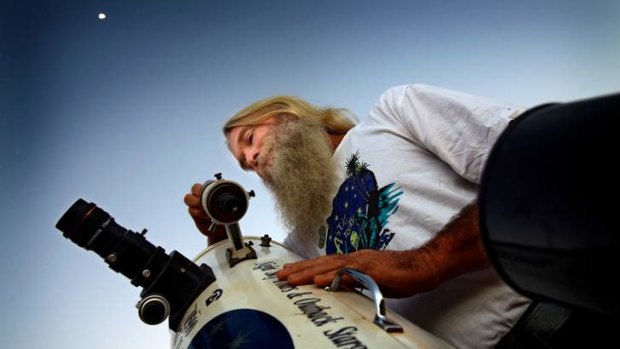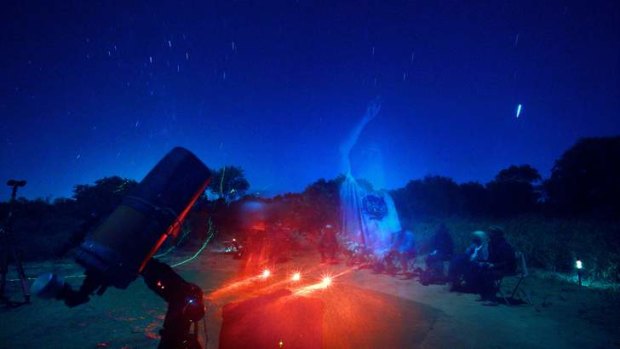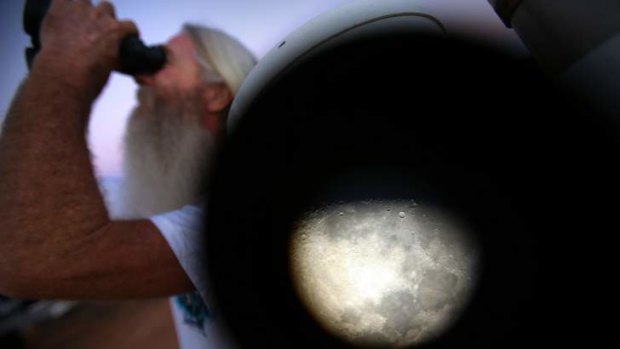
Greg Quicke sets up his telescopes.Credit: Angela Wylie
The sky's the limit in Broome, writes Melissa Fyfe.
Most nights during Broome's dry season, former mechanic and pearl diver Greg Quicke can be found just outside town between the Kimberley scrub and a quarry.
He parks his van, angles his powerful telescopes to the heavens and sets up a neat row of chairs.

Guests take in the star show.Credit: Angela Wylie
Then he waits. Soon his guests arrive, many of them locals. They come to enjoy one of Broome's lesser-known advantages: it is one of Australia's best spots to stargaze.
Broome has several things going for it when it comes to celestial tourism. It has 300 cloud-free nights a year and its northerly location is so far up on Earth's curve you can see all the southern hemisphere's constellations and most of the northern hemisphere's.
The long-bearded Quicke, who seems to love motorbikes, surfing and the moon in equal measure, is a self-taught astronomer whose classroom was the Kimberley and its extraordinary night skies. His interest in the moon was, at first, practical: as a former pearl diver he needed to know when the big tides were due.

Greg Quicke sets up his telescopes.Credit: Angela Wylie
Then later, as a mechanic in some of the Kimberley's more remote reaches, he would lie in his swag and not fall asleep until he spotted a falling star (this usually took about 10 minutes).
This was when he started to think about all the constellations he didn't know and how they tracked across the night sky - during the night and over the course of months.
Eventually, Quicke bought himself some telescopes and in 1995 began Greg Quicke's Astro Tours ($65 an adult, $35 for children). Through his powerful equipment you can see the finer details of the moon's surface and admire Saturn and its rings, which looks a little like a cartoon version of itself through the telescope.
The telescopes also magnify some often unnoticed hidden gems, like the pretty Jewel Box cluster of stars near the Southern Cross.
With a laser pointer, Quicke also takes you on a two-hour tour of the universe, from the brightest planet, Venus, to the brightest star, Sirius. He highlights the movement of key stars and planets across the night sky (the funny-sounding ones, like Zubenelgenubi, are often the kids' favourites) and you can ask Quicke any question you've ever had about the Southern Cross, the Milky Way or your favourite constellation. He is sure to have an answer.
Quicke is not only keen on facts, but a certain philosophy.
It's been centuries since we discovered that Earth orbits the sun, yet all our language to describe the sun is wrong-headed, he believes. The sun, of course, doesn't "go down" or "come up". Quicke would prefer us to describe sunset as "the Earth turning away from the part of the sky the sun is in" (a mouthful, but correct).
But every night, as he sets up his telescopes and chairs and hot chocolate for later, he hopes his guests, more than anything, leave with a sense of being "on a planet as it hurtles through space" (at a rate of about 107,300km/h to be more precise).
He encourages people to keep an eye on the night sky and see how the constellations and planets appear to shift over time.
"Even though we know intellectually that the Earth is turning and hurtling through space, we can make these movements real in our lives."
See astrotours.net.
The writer experienced Astro Tours courtesy of WA Tourism.
Sign up for the Traveller Deals newsletter
Get exclusive travel deals delivered straight to your inbox. Sign up now.